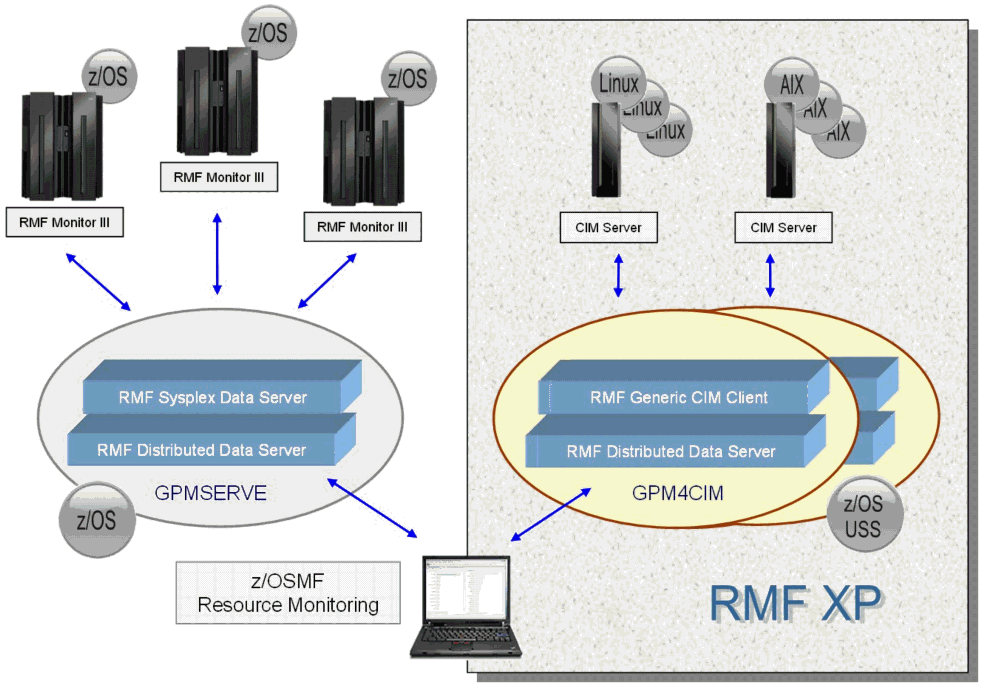Cross platform monitoring with RMF XP
For installations running operating systems other than z/OS, RMF XP provides a solution to monitor the performance of heterogeneous environments. RMF XP supports the following operating systems:
- AIX® on System p
- Linux on System x
- Linux on z Systems®
RMF XP has been tested for the following versions or distributions of the supported operating systems:
- Red Hat RHEL 5.6, 6.0, and 7.0
- SUSE SLES 11 and SLES 12
- AIX 6.1.0 and 7.1.0
Hence, with RMF XP, you can monitor operating systems that run in an IBM® Z environment, including the IBM z BladeCenter Extension (zBX)
Additionally, RMF XP does not require any proprietary agent software on the monitored endpoints. It exploits the existing Common Information Model (CIM) instrumentation for the AIX and Linux operating systems. The CIM server, as well as the metric providers, are integral parts of the supported AIX and Linux distributions, and therefore no additional software needs to be installed. You just need to ensure that the CIM servers with their metric providers are properly set up and running on the monitored endpoints.
With regard to Linux, RMF XP can communicate with two different CIM server implementations, the Open Pegasus CIM server and the Small Footprint CIM Broker (SFCB).
The core component of RMF XP is the GPM4CIM server. Similar to the Distributed Data Server (DDS) for z/OS (also known as GPMSERVE), the GPM4CIM started task receives HTTP requests and sends back responses as structured XML documents. Since the GPM4CIM started task runs in the z/OS Unix environment, at least one z/OS system is needed to utilize the RMF XP component.
As shown in Figure 1, the existing RMF™ DDS for z/OS (GPMSERVE) remains unchanged and does not interfere with the RMF XP started task. Thus, RMF XP provides an additional RMF DDS flavour for the CIM instrumented operating systems AIX and Linux. For this reason the RMF XP started task is denoted as GPM4CIM.

The left part of Figure 1 shows the configuration in a z/OS environment and the right part shows the configuration in a mixed AIX and Linux environment. One instance of an RMF generic CIM client, which is a logical module of the GPM4CIM server, communicates with a CIM server residing on either a Linux or AIX system anywhere in the heterogeneous environment. In a mixed AIX and Linux environment, you need to start at least one specific GPM4CIM instance for each platform, as described in Configuration files and parameters.
You can exploit the RMF XP capabilities in the following ways:
- Users of the Resource Monitoring plug-in for the IBM z/OS Management Facility (z/OSMF) can define connections to GPM4CIM servers running in the z/OS Unix environment. Thus, you can display performance data from AIX and Linux systems in the same way as z/OS performance data (see also z/OS Management Facility - Resource Monitoring). Of course, you can also combine performance data from different platforms into a common view as required.
- Besides handling requests for z/OS performance data, the HTTP API of the DDS can serve requests for AIX and Linux performance data as well, as soon as a GPM4CIM instance is configured and active. The DDS returns the requested data as a structured XML document. See the z/OS RMF Programmer's Guide for the documentation of the DDS HTTP API.
- You can exploit the capability of RMF XP to monitor the long-term performance
history of AIX and Linux
systems. For this purpose, you request
that performance data collected from the managed endpoints is written to SMF record type 104. Thus,
RMF XP offers a standard method for detailed long-term performance analysis and capacity planning.
For information on how to request the collection of SMF record type 104 from the systems of all or selected supported platforms, refer to How to use RMF XP for long-term performance analysis.